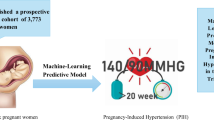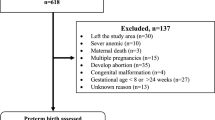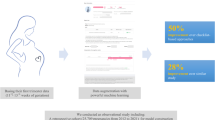Abstract
To make early predictions of preeclampsia before diagnosis, we developed and validated a new nomogram for the early prediction of preeclampsia in pregnant Chinese women. A stepwise regression model was used for feature selection. Multivariable logistic regression analysis was used to develop the prediction model. We incorporated BMI, blood pressure, uterine artery ultrasound parameters, and serological indicator risk factors, and this was presented with a nomogram. The performance of the nomogram was assessed with respect to its calibration, discrimination, and clinical usefulness. Internal validation was assessed. The signature, which consisted of 11 selected features, was associated with preeclampsia status (P < 0.1) for the development dataset. Predictors contained in the individualized prediction nomogram included BMI, blood pressure, uterine artery ultrasound parameters, and serological indicator levels. The model showed good discrimination, with an area under the ROC curve of 0.8563 (95% CI: 0.8364–0.8761) and good calibration. The nomogram still had good discrimination and good calibration when applied to the validation dataset (area under ROC curve of 0.8324, 95% CI: 0.7873–0.8775). Decision curve analysis demonstrated that the nomogram was clinically useful. The nomogram presented in this study incorporates BMI, blood pressure, uterine artery ultrasound parameters, and serological indicators and can be conveniently used to facilitate the individualized prediction of preeclampsia.
This is a preview of subscription content, access via your institution
Access options
Subscribe to this journal
Receive 12 print issues and online access
$259.00 per year
only $21.58 per issue
Buy this article
- Purchase on Springer Link
- Instant access to full article PDF
Prices may be subject to local taxes which are calculated during checkout





Similar content being viewed by others
References
De Kat AC, Hirst J, Woodward M, Kennedy S, Peters SA. Prediction models for preeclampsia: a systematic review. Pregnancy Hypertens. 2019;16:48–66.
Khan KS, Wojdyla D, Say L, Gülmezoglu AM, Van Look PF. WHO analysis of causes of maternal death: a systematic review. Lancet. 2006;367:1066–74.
Bian X, Biswas A, Huang X, Lee KJ, Li TK, Masuyama H, et al. Short-term prediction of adverse outcomes using the sFlt-1 (soluble fms-like tyrosine kinase 1)/PlGF (placental growth factor) ratio in Asian women with suspected preeclampsia. Hypertension. 2019;74:164–72.
Agrawal S, Shinar S, Cerdeira AS, Redman C, Vatish M. Predictive performance of plgf (placental growth factor) for screening preeclampsia in asymptomatic women: a systematic review and meta-analysis. Hypertension. 2019;74:1124–35.
Yue CY, Ying CM. Epidemiological analysis of maternal lipid levels during the second trimester in pregnancy and the risk of adverse pregnancy outcome adjusted by pregnancy BMI. J Clin Lab Anal. 2018;32:e22568.
Yu CK, Smith GC, Papageorghiou AT, Cacho AM, Nicolaides KH, Fetal Medicine Foundation Second Trimester Screening Group. An integrated model for the prediction of preeclampsia using maternal factors and uterine artery Doppler velocimetry in unselected low-risk women. Am J Obstet Gynecol. 2005;193:429–36.
Goetzinger KR, Tuuli MG, Cahill AG, Macones GA, Odibo AO. Development and validation of a risk factor scoring system for first-trimester prediction of preeclampsia. Am J Perinatol. 2014;31:1049–56.
Kenny LC, Black MA, Poston L, Taylor R, Myers JE, Baker PN, et al. Early pregnancy prediction of preeclampsia in nulliparous women, combining clinical risk and biomarkers: the Screening for Pregnancy Endpoints (SCOPE) international cohort study. Hypertension. 2014;643:644–52.
American College of Obstetricians and Gynecologists: Hypertension in pregnancy. ACOG Tech Bull. 1996;219:1–8.
Holick MF, Binkley NC, Bischoff-Ferrari HA, et al. Evaluation, treatment, and prevention of vitamin D deficiency: an Endocrine Society clinical practice guideline. J Clin Endocrinol Metab. 2011;96:1911–30.
WHO Expert Consultation. Appropriate body-mass index for Asian populations and its implications for policy and intervention strategies. Lancet. 2004;363:157–63.
Collins GS, Reitsma JB, Altman DG, Moons KG. Transparent reporting of a multivariable prediction model for individual prognosis or diagnosis (TRIPOD): The TRIPOD statement. BMJ. 2015,350:g7594.
Vickers AJ, Cronin AM, Elkin EB, Gonen M. Extensions to decision curve analysis, a novel method for evaluating diagnostic tests, prediction models and molecular markers. BMC Med Inf Decis Mak. 2008;8:53.
Phipps E, Prasanna D, Brima W, Jim B. Preeclampsia: updates in pathogenesis, definitions, and guidelines. Clin J Am Soc Nephrol. 2016;11:1102–13.
Avagliano L, Bulfamante GP, Morabito A, Marconi AM. Abnormal spiral artery remodelling in the decidual segment during pregnancy: from histology to clinical correlation. J Clin Pathol. 2011;64:1064–8.
Campbell S, Black RS, Lees CC, Armstrong V, Peacock JL. Doppler ultrasound of the maternal uterine arteries: disappearance of abnormal waveforms and relation to birthweight and pregnancy outcome. Acta Obstet Gynecol Scand. 2000;79:631–4.
Roberts JM, Cooper DW. Pathogenesis and genetics of pre-eclampsia. Lancet. 2001;357:53–6.
Frusca T, Soregaroli M, Platto C, Enterri L, Lojacono A, Valcamonico A. Uterine artery velocimetry in patients with gestational hypertension. Obstet Gynecol. 2003;102:136–40.
Reister F, Frank HG, Kingdom JC, Heyl W, Kaufmann P, Rath W, et al. Macrophage-induced apoptosis limits endovascular trophoblast invasion in the uterine wall of preeclamptic women. Lab Invest. 2001;81:1143–52.
Konje JC, Kaufmann P, Bell SC, Taylor DJ. A longitudinal study of quantitative uterine blood flow with the use of color power angiography in appropriate for gestational age pregnancies. Am J Obstet Gynecol. 2001;185:608–13.
Singnoi W, Wanapirak C, Sekararithi R, Tongsong T. A cohort study of the association between maternal serum Inhibin-A and adverse pregnancy outcomes: a population-based study. BMC Pregnancy Childbirth. 2019;19:124.
Shen Z, Cai LY, Suprapto IS, Shenoy P, Zhou X. Placental and maternal serum inhibin A in patients with preeclampsia and small-for-gestational-age. J Obstet Gynaecol Res. 2011;37:1290–6.
Zeeman GG, Alexander JM, McIntire DD, Byrd W, Leveno KJ. Inhibin-A levels and severity of hypertensive disorders due to pregnancy. Obstet Gynecol. 2002;100:140–4.
Xu YT, Shen MH, Jin AY, Li H, Zhu R. Maternal circulating levels of transforming growth factor-β superfamily and its soluble receptors in hypertensive disorders of pregnancy. Int J Gynaecol Obstet. 2017;137:246–52.
Eche S, Mackraj I, Moodley J. Circulating fetal and total cell-free DNA, and sHLA-G in black South African women with gestational hypertension and pre-eclampsia. Hypertens Pregnancy. 2017;36:295–301.
Nerenberg KA, Park AL, Vigod SN. Long-term risk of a seizure disorder after eclampsia. Obstet Gynecol. 2017;130:1327–33.
El Khouly NI, Sanad ZF, Saleh SA, Shabana AA, Elhalaby AF, Badr EE. Value of first-trimester serum lipid profile in early prediction of preeclampsia and its severity: a prospective cohort study. Hypertens Pregnancy. 2016;35:73–81.
Yalamati P, Bhongir AV, Betha K, Verma R, Dandge S. Relationship of serum uric acid, serum creatinine and serum cystatin C with maternal and fetal outcomes in rural Indian pregnant women. Int J Reprod Contracept Obstet Gynecol. 2015;4:1505–10.
Escudero C, Bertoglia P, Muñoz F, Roberts JM. Uric acid and purine plasma levels as plausible markers for placental dysfunction in pre-eclampsia. Rev Med Chil. 2013;141:895–902.
Weissgerber TL, Milic NM, Turner ST, Asad RA, Mosley TH, Kardia SL, et al. Uric acid: a missing link between hypertensive pregnancy disorders and future cardiovascular disease? Mayo Clin Proc. 2015;90:1207–16.
Masoura S, Makedou K, Theodoridis T, Kourtis A, Zepiridis L, Athanasiadis A. The involvement of uric acid in the pathogenesis of preeclampsia. Curr Hypertens Rev. 2015;11:110–5.
Collins GS, Reitsma JB, Altman DG, Moons KG. Transparent reporting of a multivariable prediction model for individual prognosis or diagnosis (TRIPOD): the TRIPOD statement. Br J Surg. 2015;102:148–58.
Balachandran VP, Gonen M, Smith JJ, DeMatteo RP. Nomograms in oncology: more than meets the eye. Lancet Oncol. 2015;16:e173–80.
De Kat AC, Hirst J, Woodward M, Kennedy S, Peters SA. Prediction models for preeclampsia: a systematic review. Pregnancy Hypertens. 2019;16:48–66.
Albaiges G, Missfelder-Lobos H, Lees C, Parra M, Nicolaides KH. One-stage screening for pregnancy complications by color Doppler assessment of the uterine arteries at 23 weeks’ gestation. Obstet Gynecol. 2000;96:559–64.
Funding
This work was supported by the program for National Natural Science Foundation of China (No. 81902131) and Shanghai Medical Academy New Star Young Medical talents training subsidy Program (Shanghai Health personnel 2020-087).
Author information
Authors and Affiliations
Contributions
C-YY analyzed the data, drafted the manuscript and contributed to the study design. J-pG contributed to the data analysis. C-yiZ and Y-hN contributed to data collection. C-MY revised the article. All authors reviewed and edited the manuscript and approved the final version of the manuscript.
Corresponding author
Ethics declarations
Conflict of interest
The authors declare that they have no conflict of interest.
Ethical approval
The present study conformed to the principles of the Declaration of Helsinki. Approval was obtained from the Research Ethics Committee of the Obstetrics & Gynecology Hospital of Fudan University (approval number: 2019-06).
Additional information
Publisher’s note Springer Nature remains neutral with regard to jurisdictional claims in published maps and institutional affiliations.
Rights and permissions
About this article
Cite this article
Yue, Cy., Gao, Jp., Zhang, Cy. et al. Development and validation of a nomogram for the early prediction of preeclampsia in pregnant Chinese women. Hypertens Res 44, 417–425 (2021). https://doi.org/10.1038/s41440-020-00558-1
Received:
Revised:
Accepted:
Published:
Issue Date:
DOI: https://doi.org/10.1038/s41440-020-00558-1
Keywords
This article is cited by
-
Preeclampsia up to date—What’s going on?
Hypertension Research (2023)
-
Association of first trimester serum uric acid with preeclampsia: an observational cohort study with propensity score matching
Hypertension Research (2023)



